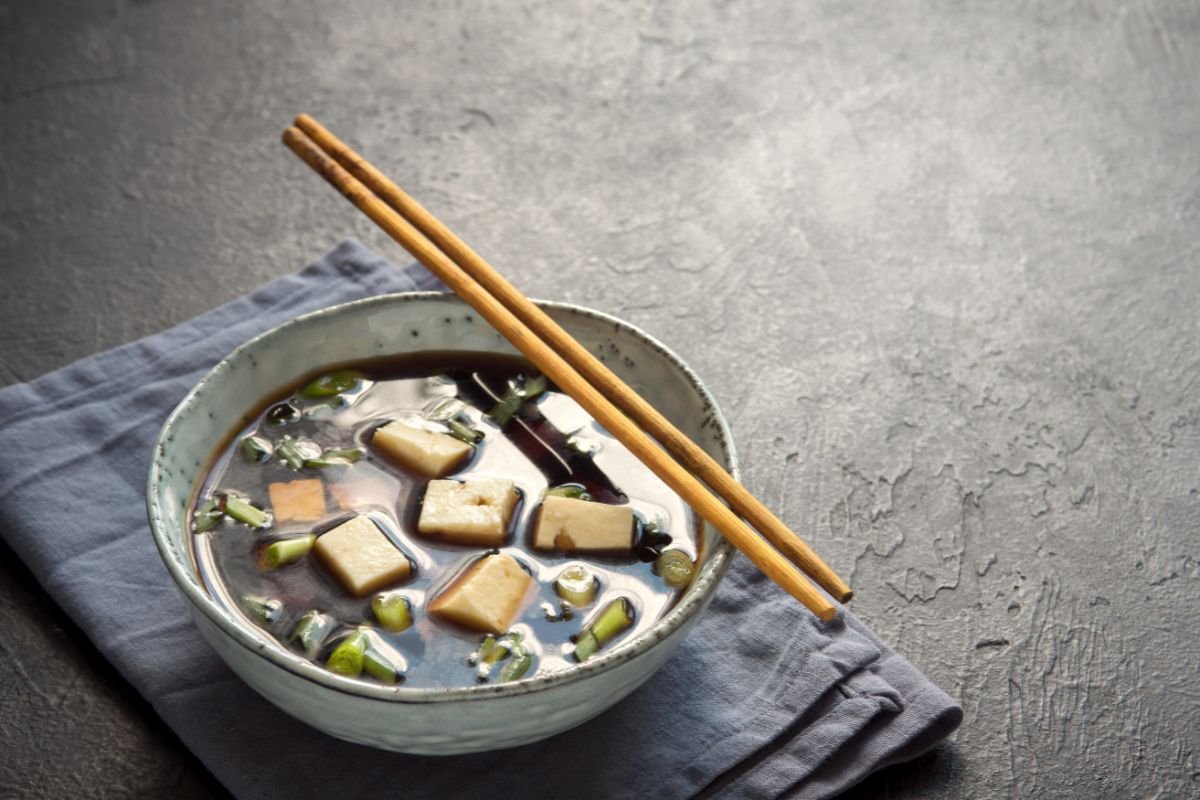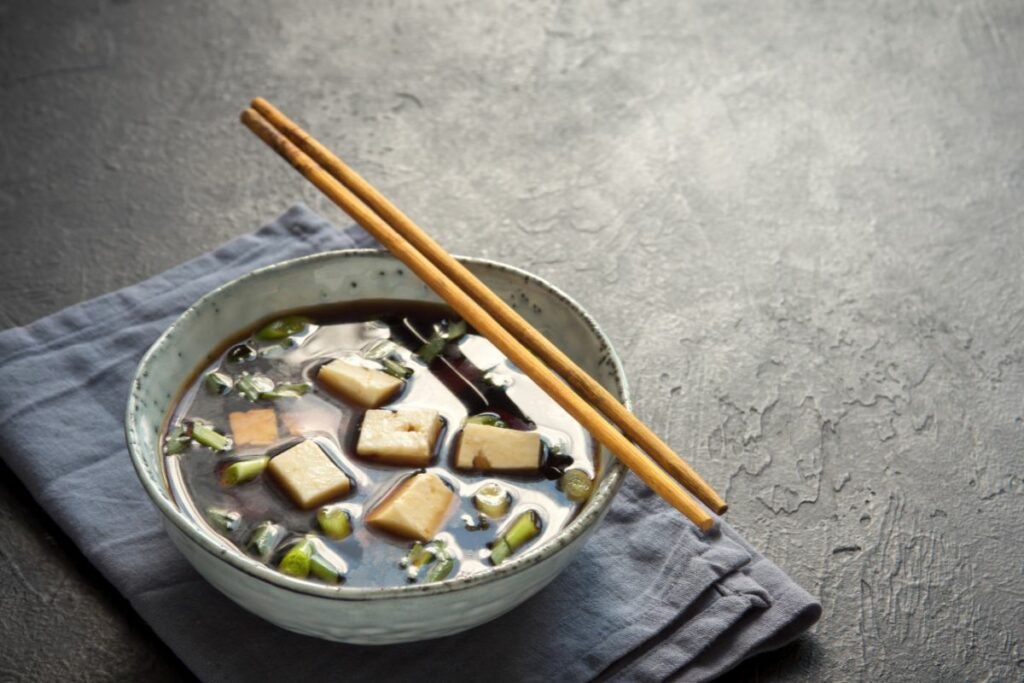Winter and low temperatures make us all look for nutritious and refreshing foods, and what better than a hot, wholesome soup? Those who have visited a Chinese or Japanese restaurant, have certainly seen on the menu a very typical appetizer dish of Asian cuisine: the miso soup.

Miso paste is prominent as an ingredient and is used daily in many dishes, and miso soup is one of them. But what does miso, and in turn, miso soup taste like exactly? And why is it so good for us?
What Is Miso?
MIso is a kind of paste that is prepared mainly from soybeans, sea salt, and rice or barley, which have undergone long-term fermentation with special enzymes.
It is very interesting that the Asians, realizing that soy is a very invigorating but a relatively indigestible food, found ways to process it and make it more digestible and nutritious and we find it in tofu, tempeh, miso, soy sauce, and tamari.
What Does Miso Soup Taste Like?
The best way to describe miso soup is that it is highly flavorful. Yet, every single one of the components contributes to giving it a variety of different essences.
Because miso soup is topped with fresh green onions, you’ll certainly get that oniony taste and texture when eating it, whereas the seaweed used to make miso and the soy sauce added in the soup are two of the main reasons why this soup is savory and salty.
Furthermore, the tofu that is added to the soup gives a delicate, nutty flavor that does wonders at balancing out the saltiness of the other ingredients. Speaking in cooking terms, miso soup is one of those perfectly balanced and wholesome umami dishes.
I should also note that, at times, miso soup can taste a bit fishy. That is because many people use dashi, a fish stock, to prepare the soup. Others keep it simple and just add bonito flakes, but don’t think that you ordered the wrong soup if you end up tasting a miso soup that is a bit fishy.
However, if you are a vegetarian, it is better to ask first than be sorry later!
What Are The Different Types Of Miso Paste?
Some miso pastes are saltier than others (we’ll get into that in a bit), so you can always find the one that’s closer to your taste. However, each one of them is meant to go with specific dishes, so you should probably trust the tradition and not mix things up!
For reference though, these are the three different miso pastes available:
Shiro Miso
This is the white miso, as it is otherwise called, and is the most widespread in the world. It has undergone the least fermentation and is softer and sweeter (the most intense miso is a bit bitter).
Precisely because it is milder in taste than others, it is the most practical of all, as it has a wide range of uses, from soups, stir-fries, and salads to desserts.
Shinshu Miso
This is the yellow miso, which is a little stronger in taste than the white. This is usually made with barley and can be used in various recipes, with slightly more intense results.
Aka Miso
It is red miso, which is the most intense in color, taste, and aroma. It has undergone the longest fermentation, up to 3 years. A small amount is enough to give flavor and it is ideal for meats or vegetables, but also sauces.
It is also widely used so long as one pays attention to the quantity as it is the strongest one in all perspectives: saltiness, tastes, and so on.
Hatcho Miso
It is the purest miso paste, made only with soy and without other cereals, which makes it suitable for celery. Its color is almost black, its taste is deep and spicy, and its texture is so firm that it can’t be cut and is difficult to dilute.
What Are The Ingredients For Miso Soup?
Here are the ingredients for 2 servings with some instructions on how to make your own miso soup.
To Make The Soup You Will Need
- 500 ml dashi or vegetable broth (preferably mushrooms)
- 30 gr. hatcho miso, or 40 gr. white miso paste (if you prefer a stronger miso taste, just add more of it)
- 1-2 tbsp. dried wakame seaweed (we can replace them with ½ -1 cup spinach leaves or kale, coarsely chopped)
- 1 chopped green onion (including the green part)
- 100 gr. tofu, cut into cubes
- 2 tbsp. sesame, slightly roasted
Instructions
- Put the seaweed to soak in a bowl of water for 10-15 minutes, to double in volume.
- Place a saucepan over medium heat and prepare the broth.
- Bring to a boil, remove from the heat, and dissolve the paste. Divide the seaweed and the tofu into two bowls and pour over the soup. Garnish with chopped onions and a little sesame optional. Serve immediately.
Why Is Miso Soup So Great?

Miso pastes are beneficial for the digestive system and specifically for the function of the intestine since they are rich in probiotics.
Research in recent years has shown that miso pastes that are rich in isoflavones (natural estrogenic ingredients found in soy) may provide some protection against various types of cancer, such as breast cancer and prostrate cancer, and are lauded by some as beneficial for women who have entered menopause. But, of course, please seek professional advice on all health matters, before taking action.
Due to the enzymes that are responsible for the fermentation process, miso greatly helps digestion, stimulates, and cleanses the blood and gives a lot of energy to the body, providing trace elements, minerals, and vitamins (especially B12), and is considered to help protect against radioactivity.
It is also a very good source of manganese, zinc, and vitamin K, which is essential for the absorption of vitamin D – one of the most important vitamins, which in recent years has lost a lot of weight.
In general, the consumption of fermented foods, such as pickles, kefir, kombucha, miso, etc., is particularly beneficial for the body, as they shield us from infections and can have an action like that of antibiotics (and in a much more natural way).
Therefore, miso soup is consumed throughout the year and is considered one of the healthiest soups in the world.
The Bottom Line
We hope you found this article helpful and are now on your way to the supermarket to buy all the ingredients you need to make a miso soup for dinner.
This soup is not only healthy but extremely delicious too, so don’t hesitate to try it. And, if you don’t feel like cooking, I’m certain there’s an Asian restaurant around you can visit!
- What Is a Maiko? - July 13, 2025
- What Does Domo Arigato Mean? - July 12, 2025
- What Does Naruto Mean? - July 12, 2025









